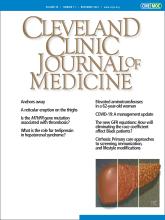
Before you read this, please read the article by Prakash et al,1 part of our Symptoms to Diagnosis series.
The Journal has published reviews and commentaries on the nuanced interpretation of laboratory tests. In the article by Prakash et al, challenges that arose while pursuing the diagnosis highlight limitations in how we interpret some of our most-ordered tests, as well as those we order more selectively. As you follow the authors’ clinical reasoning behind the management of the 62-year-old patient, it is easy to see how results of nonspecific tests can be interpreted to support a diagnosis that is ultimately incorrect. Using results of less-specific tests to support a specific diagnosis without actively recognizing the limitations of the tests can lead to premature closure (“anchoring”), one of the deadly sins of clinical reasoning.
Three points in Prakash’s teaching exercise struck me. The first is one that I have written about and have perseverated about with scores of medical residents. “Liver function tests” are definitely not as the name implies. They have little to do with liver function and, most importantly, when elevated, they do not unequivocally indicate a hepatic source. We must resist following the implicit implications in using the term liver function test. Aspartate aminotransferase and alanine aminotransferase are present in many cells, including myocytes.
Liver disease is far more common than muscle disorders as a cause of aminotransferase elevation, so elevated aspartate and alanine aminotransferase levels will indeed most likely reflect hepatic injury. Symptoms of chronic liver and muscle disease that patients report are frequently similar, ie, fatigue and weakness. Unless we push to understand what “weakness” means to the specific patient (eg, general listlessness vs difficulty getting up from the toilet or from a low chair), it is easy to see how chronic myositis could be diagnosed as hepatitis. While this can usually be sorted out by checking the creatine kinase level, it takes clinical suspicion followed by an active decision to order this test. That suspicion usually arises from hearing an appropriately detailed history from the patient or the patient’s family, or by the physical examination. Alternatively, the decision to order a creatine kinase test can (should?) be algorithmically made in all patients with elevated aminotransferases who do not have more direct evidence for hepatic pathology—eg, elevated gamma-glutamyl transferase, elevated hepatic alkaline phosphatase, or abnormal liver imaging.
The second point is our need to recognize and accept that notes in the medical record that a patient has been “asymptomatic” with a “normal physical examination” may not tell the whole story. Particularly, as clinicians are pressed for time during visits, and many of us wind up entering or completing our notes after the end of our clinic day is done, shortcuts like the use of visit-note templates pose challenges. Few of us have time to complete a full physical examination and obtain a detailed review of systems at every visit. We complete a more directed examination based on symptoms and prior history, and the review of symptoms is likely to be based on an obliquely worded, patient-completed questionnaire. So if there was no reason to seriously consider a myopathy, how likely was a truly focused evaluation of a patient’s strength performed? Was the patient asked specifically about muscle fatigue with brushing the hair or difficulty walking up steps? Did we examine strength in the office—eg, how many seconds does it take the patient to sit and arise 10 times from a chair without using the arms to push off? I have found, especially when note templates have been used, that there are discrepancies in physical examination findings. Was the patient discussed by Prakash et al truly without any previous muscle symptoms or findings that might have provided a hint as to the nonhepatic source of the “liver tests”?
The third learning point relates to the limited utility of autoimmune serologies, the most frequently ordered test being the antinuclear antibody (ANA). ANA is not a specific test. It is positive in almost all patients with systemic lupus and scleroderma, and in many patients with rheumatoid arthritis, autoimmune thyroid disease, myositis, and Sjögren syndrome. Importantly, it can be detected (usually in lower titers) in about 20% of patients without clinically recognized systemic autoimmune disease. Indiscriminate ordering of the test is costly and may lead clinicians and patients down many a vexing rabbit hole. Up to 40% of patients with autoimmune liver disease have a second systemic autoimmune disorder, perhaps one associated with positive for ANA. But a positive ANA is also present in many patients with autoimmune liver disease (ALD), so when that diagnosis is suspected, ANA and more-specific autoantibodies like anti-smooth muscle and anti-mitochondrial are often ordered, and a positive test result is used to support the diagnosis of ALD. But as in the patient discussed by Prakash et al, the highly positive but less specific ANA test likely reflected the previous diagnosis of Sjögren syndrome. Not accepting the true nonspecificity of this test, and interpreting it in the context of the suspected diagnosis of autoimmune hepatitis, likely led to stronger initial acceptance of the diagnosis of ALD than was warranted.
The discussion by Prakash et al highlights the importance of resisting the reflex use of less-specific tests to anchor a provisional diagnosis without intentionally considering alternative interpretations of those results that might push towards a different diagnosis.
- Copyright © 2023 The Cleveland Clinic Foundation. All Rights Reserved.






